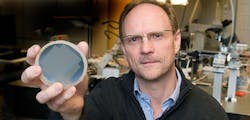Göteborg, Sweden--A new record for error-free data transmission rates at 850 nm using a directly modulated oxide-confined vertical cavity surface emitting laser (VCSELs) has been set by researchers at Chalmers University of Technology. In a back-to-back laser configuration the team achieved bit rates up to 40 Gbit/s, while over 100 m of multimode fiber rates up to 35 Gbit/s were achieved.
Commercially available data communications VCSELs (and edge emitting devices) currently operate at data rates up to 10 Gbit/s and significant development efforts are underway globally to raise data rates using a variety of different schemes.
Vertical cavity lasers are very attractive as an optical communications source. The devices can be fabricated and tested at the wafer level--before they are cut into individual chips for packagingâso manufacturing costs are significantly lower than for edge-emitting lasers.
Commercially available data communications VCSELs (and edge emitting devices) currently operate at data rates up to 10 Gbit/s and significant development efforts are underway globally to raise data rates using a variety of different schemes.
Vertical cavity lasers are very attractive as an optical communications source. The devices can be fabricated and tested at the wafer level--before they are cut into individual chips for packagingâso manufacturing costs are significantly lower than for edge-emitting lasers.
Furthermore, the VCSELs are smaller so they require less power (~ 10%) to achieve performance equivalent to that of edge emitters, which also simplifies thermal management of the packaged devices.
The team originally reported its findings in IEEE Electronic Letters.
The research was performed at the Chalmers research center FORCE. It is funded by Swedish Foundation for Strategic Research, SSF, and by the EU through the project VISIT. Participating companies in the European project are IQE Europe (UK), VI Systems (Germany) and Intel (Ireland). Informal partners in the project are Tyco Electronics and Ericsson (both Sweden).
Source: Chalmers Publication LibraryPosted by:Steve AndersonSubscribe nowtoLaser Focus Worldmagazine; Itâs free!
Follow us on TwitterFollow OptoIQ on your iPhone. Download the free Apphere
Sponsored Recommendations
Sponsored Recommendations
Voice your opinion!
Voice your opinion!
